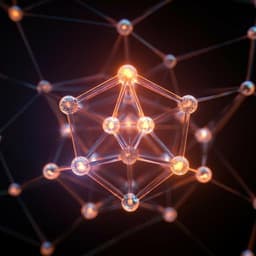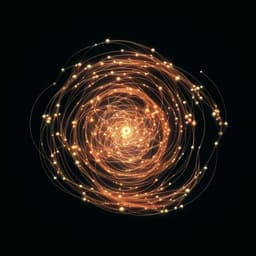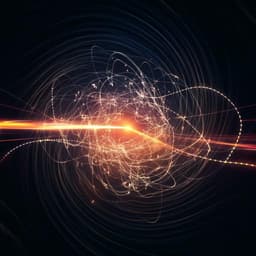
Physics
Preparing remote states for genuine quantum networks
S. Chen, C. Hsu, et al.
Discover the groundbreaking work by Shih-Hsuan Chen and colleagues that delves into remote state preparation (RSP) in quantum networks. This research not only measures a new quantum resource—RSP capability—but also uncovers the nuances between classical and quantum RSP implementations based on photon-pair quality, revealing significant quantum advantages!
~3 min • Beginner • English
Introduction
The paper addresses whether practical implementations of remote state preparation (RSP) in quantum networks can be certified as genuinely quantum, i.e., outperform any classical emulation that uses no entanglement or qubit unitaries. RSP enables a sender (Alice) to remotely prepare a receiver’s (Bob’s) qubit state using shared resources and local measurements, with advantages over teleportation for certain tasks (e.g., requiring only local measurements on Alice’s particle). RSP underpins applications from deterministic single-photon state preparation and hybrid entanglement to initializing quantum memories for communication, blind quantum computation, measurement-based quantum information processing, and entanglement-enabled networks. However, existing verification approaches based on quantum discord, EPR steering, or RSP benchmarks assume ideal quantum models and cannot, in general, exclude classical descriptions in noisy, practical settings. The research introduces a dynamic resource—RSP capability—as a necessary condition to demonstrate nonclassical RSP and to validate genuine quantum networks that employ RSP for state preparation and transmission. The study’s purpose is to define, model, and experimentally measure this capability, and to show that discord alone does not guarantee nonclassical RSP.
Literature Review
Prior works established RSP protocols and advantages over teleportation and showed the relevance of measurement-based quantum information processing (one-way computation) and entanglement-enabled networks. Quantum discord has been proposed as a resource for RSP and quantified via geometric measures; EPR steering and benchmarks for teleportation and RSP fidelity have been explored. Nonetheless, these approaches may not confirm nonclassical implementations in realistic scenarios where classical imperfections can model the process. The present work builds on these foundations by proposing a classical RSP emulation model consistent with process tomography, contrasting dynamic resource-based certification with static state-based criteria (entanglement, discord, steering).
Methodology
The authors formalize RSP as a quantum operation using both static (shared EPR pairs) and dynamic (local unitary U, classical communication, Bob’s correction) resources. For ideal deterministic or heralded RSP, the operation is R_RSP(ρ_i) = U ρ_i U†, mapping input pure states to target outputs. In a network, RSP concatenates with a quantum channel/network Q_N (e.g., teleportation, repeaters): Q_N∘R_RSP(ρ_i) = ρ_f. They use quantum process tomography to obtain an experimental process matrix χ̃_𝓔 (positive Hermitian), enabling reconstruction of output states for arbitrary inputs via the Pauli basis. A classical networking RSP model is constructed with no EPR pairs and no qubit unitaries: instead, a classical source provides pairs (v_A, p_x), where v_A encodes pre-existing measurement outcomes for σ_x, σ_y, σ_z with deterministic values ±1 (realism), and p_x provides Bob’s qubit drawn from a distribution p(x). Alice sends one bit indicating a randomly chosen pre-existing outcome; Bob’s (or Charlie’s) conditional state averages to a form that yields a valid classical process matrix χ_c via substitutions into the process matrix definition. This defines a classical output mapping ρ → ρ_cs and, for networks containing any classical subnetwork, ρ → ρ_cs overall. RSP capability is then defined as the property of a process χ_𝓔 not simulable by χ_c for all inputs, indicating the presence of nonclassical state preparation/transmission in the network. Three quantitative criteria are proposed and computed via semidefinite programming (SDP): (i) RSP composition α, expressing χ_𝓔 as a convex mixture of a classical process χ_c and a remainder χ_q not representable classically; α is the maximum weight of nonclassicality (α = min α with χ_𝓔 = α χ_q + (1−α) χ_c). (ii) RSP robustness β, the minimum noise weight b such that (χ_𝓔 + b χ_noise)/(1+b) becomes classical; β quantifies noise required to destroy nonclassicality. (iii) Average-state-fidelity criterion: F_av(φ) = ∫ ds_i ⟨s_i| U(φ) ρ_out U†(φ) |s_i⟩ must exceed the classical bound F_c ≈ 78.9% (derived from maximal process fidelity F_c_proc = 0.683 via F = (2 F_c_proc + 1)/3). For ideal networking RSP, α = 1, β = 0.464, F_av = 1. Optimization problems for α, β, and F_c are cast as SDPs with constraints enforcing positivity and process-matrix structure, solved numerically (MATLAB/YALMIP/SDPT3). Experimentally, polarization-entangled photon pairs are generated via a polarization Sagnac interferometer (ppKTP, 405 nm pump, 810 nm photons), yielding ~1000 pairs/s and state fidelity F = 98.62 ± 0.26% to the target entangled state. Alice’s operation U = R(φ) and Bob’s corrections are implemented with waveplates; a passive RSP scheme collects events with and without corrections as heralded outcomes. Full process tomography on Bob’s outputs conditioned on Alice’s measurements yields χ_𝓔, from which α, β, and F_av are computed. Noise is introduced by mixing the entangled state with (a) an incoherent separable mixture ρ_sep and (b) a Werner admixture with identity, to probe transitions between nonclassical and classical RSP.
Key Findings
- Ideal-like nonclassical RSP at φ = 0 and φ = π: Measured processes exhibit strong RSP capability with α ≈ 0.99, β ≈ 0.44–0.46, and average process fidelity F ≈ 0.98, close to the ideal benchmarks (α = 1, β = 0.464, F_av = 1). Output states on the Bloch sphere show larger vector lengths than best classical emulations. - Classical fidelity threshold: The classical average-state-fidelity bound is F_c ≈ 78.9%. - Transition under noise (incoherent mixture): Mixing ρ_expt with ρ_sep = (|0⟩⟨0|⊗|1⟩⟨1| + |1⟩⟨1|⊗|0⟩⟨0|)/2 yields RSP processes that lose nonclassicality above a noise threshold. At mixing parameter p_ρ = 0.4, despite nonzero quantum discord (theory ≈ 0.075; experiment ≈ 0.054) and EPR steerability (SW_theory ≈ 0.183; SW_expt ≈ 0.095), the RSP fails to surpass the classical fidelity: F_theory ≈ 78.62%, F_expt = (78.27 ± 0.03)%, hence classical. - Transition under Werner noise: For ρ_W(p_noise) = (1 − p_noise) ρ_expt + p_noise I, RSP can become fully classical (α = 0, β = 0) even with states exhibiting quantum discord (e.g., p_noise = 0.5 shows discord but no RSP capability). - Discord and EPR steering are not sufficient: Observing quantum discord and/or EPR steerability in shared photon pairs does not ensure nonclassical RSP; only RSP capability certification via α, β, and fidelity beyond F_c confirms genuine quantum networking behavior. - Practical validation: The RSP capability framework provides an operational, process-level validation that the combined static and dynamic network elements (sources, channels, operations, and classical communication) collectively realize nonclassical remote state preparation and transmission.
Discussion
The study demonstrates that nonclassical remote state preparation requires more than static quantum correlations in shared states; it demands a process-level capability that cannot be reproduced by any classical model lacking entanglement and qubit unitaries. By constructing a classical networking RSP model compatible with process tomography and deriving a classical process-matrix region, the authors provide operational criteria (α, β, F_av) to certify genuine quantum networks executing RSP. Experimental results show that even high-fidelity entangled sources can yield classical RSP under realistic noise, and conversely, that when the process surpasses the classical bounds, RSP capability validates the nonclassical function of the entire network stack (sources, operations, channels). This reframes verification away from static indicators (discord, steering) to a dynamic, end-to-end certification aligned with practical implementations. The approach also clarifies resource requirements for RSP-assisted networking tasks (e.g., memory initialization plus teleportation) and delineates noise thresholds necessary to maintain quantum advantages. These insights extend to measurement-based protocols broadly, where measurement-induced operations need dynamic certification to confirm nonclassical functionality.
Conclusion
The authors introduce RSP capability as a dynamic quantum resource necessary to realize nonclassical remote state preparation and transmission in quantum networks, beyond any classical emulation without entanglement and qubit unitaries. They develop a classical networking RSP model and process-matrix-based criteria—RSP composition (α), robustness (β), and an average-state-fidelity threshold (F_c ≈ 78.9%)—solved via SDP. Experiments with polarization-entangled photons validate the framework, observing nonclassical RSP near ideal operation and clear transitions to classical behavior under controlled noise, even in regimes with nonzero discord and EPR steerability. The work provides an actionable method to certify genuine quantum networks based on RSP and suggests future investigations into applications such as memory-assisted MDI-QKD, space-based networking, and broader measurement-based quantum processing, as well as potential connections to security analyses in entanglement-based QKD.
Limitations
- Experimental demonstrations are performed on polarization-encoded photonic qubits using a Sagnac ppKTP source; generalization to other platforms (e.g., atomic, superconducting) and higher-dimensional systems is not experimentally shown. - The RSP implementation is passive (no real-time feedforward), and corrections are applied statistically; while equivalent in outcome for tomography, it does not demonstrate real-time operational control. - Noise studies focus on specific admixtures (incoherent separable mixture and Werner noise); other experimentally relevant noise channels are not exhaustively explored. - Certification requires full process tomography and SDP optimization, which can be resource-intensive and may scale unfavorably with system size. - Reported nonclassical metrics are for φ = 0 and π cases; broader parameter sweeps or arbitrary U realizations are not detailed experimentally. - The classical model assumes pre-existing outcomes and one-bit classical communication consistent with the formalism; while broad, it may not encompass every conceivable classical imperfection model outside the specified constraints.
Related Publications
Explore these studies to deepen your understanding of the subject.







